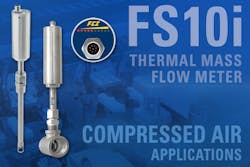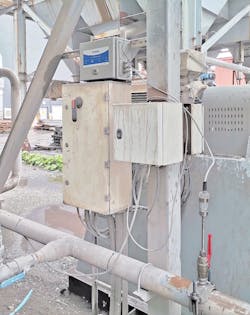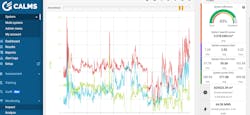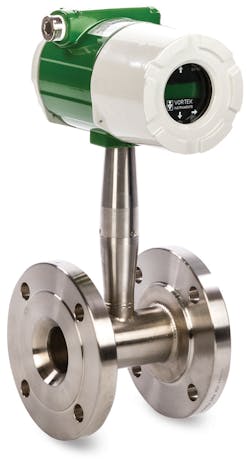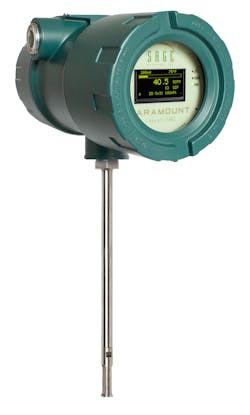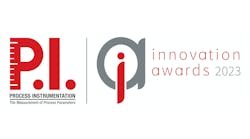P.I. Process Instrumentation's 2022 Innovation Awards winner and honorable mentions

For more than 20 years, P.I. Process Instrumentation’s annual Innovation Awards program has recognized the latest solutions in process instrumentation. The program accepts nominations from companies that would like to submit their technology breakthroughs in process instrumentation, and the winners are determined by a reader voting process. We would like to thank everyone who participated in the awards program by nominating or voting. And, congratulations to the winner and honorees. We hope to see your solution nominated next year. The following case studies highlight the technology solutions from the 2022 Innovation Awards winner and honorable mentions.
WINNER
FS10i Series Thermal Mass Flow Meter
Fluid Components International (FCI)
Thermal flow meter helps compressed air system manufacturer keep the pressure steady
Industrial compressed air system leaks have been identified for decades as a serious cost issue that also adds to the strain on the electric grid, according the U.S. Department of Energy and many other agencies around the globe. As industrialized nations now struggle with energy shortages along with much higher costs and address zero emissions goals simultaneously, the impact of leaky compressed air systems is a top priority for many companies.
According to some estimates, compressed air systems waste as much as 20% or more of the energy required to operate them. Over time, the utility costs of operating these systems will easily pay for the detection and repair of leaks or the complete replacement of obsolete systems that have served beyond their useful expected life cycle.
Detecting air/gas leaks requires accurate flow measurement. There is an old saying in industrial process control that you can’t control what you don’t measure. In the case of air compressor systems, that statement is certainly true. If ignored by plant managers and engineers, air/gas leaks make it nearly impossible to achieve reasonable plant efficiency.
The problem
When engineers at CALMS Air needed a new and more dependable flow measurement solution to monitor compressed air leaks, the company contacted the applications group at Fluid Components International (FCI) about its thermal dispersion sensing technology flow meters. CALMS Air was looking for an accurate meter with low flow measurement capabilities that could be easily installed in multiple line sizes and with ISO17025/NIST-traceable compressed air meter calibration to support its air monitoring products.
CALMS Air is a platform for ongoing compressed air optimization and manufactures several different compressed air products. The CALMS CAL-Edge device is a remote data logger for auditing compressed air systems. The CALMS CAL-PM device is a data logger for permanent monitoring and PLC control of compressed air applications. The CALMS CAL-PM EMCS is an energy management control system add-on for permanent monitoring.
CALMS Air is part of the HPE group founded in 2001. HPE is known as a total compressed air solutions provider; performing audits, projects, energy solutions, delivery, installation and maintenance of compressed air systems. CALMS headquarters is in Slovenia, although the company operates worldwide with additional locations in Sweden and New York City.
The solution
The engineers at FCI recommended the compact FS10i Thermal Flow Meter for use in CALMS Air applications. This flow meter was designed specifically for compressed air applications and other small line processes. Its advanced thermal dispersion flow sensing technology and electronics offer a number of advantages.
These compressed air measurement advantages include: thermal dispersion direct mass flow measurement requiring no additional pressure or temperature sensors (Figure 2), easy hot-tap insertion installation for temporary or permanent service, no moving parts for safety and a sealed design with no orifices to clog or foul.
The versatile FS10i Flow Meters are designed for a wide range of applications beyond air compressors. They are also ideal for any type of process or waste gas leak detection, zone monitoring, blowers, boiler and burner air and gas fuel feed lines, calciners, kilns, ovens, packaging equipment and plant sub-metering systems.
Independently third-party evaluated, the FS10i Flow Meters are the only instruments in their class to achieve SIL 2 certification as an HFT0 device. This rating makes them the optimum choice for safety instrumented systems (SIS) in critical and hazardous processes.
The FS10i Flow Meters provide a fluid-matched, calibrated and linearized 4-20mA output of flow rate, and a user programmable high or low flow alarm/trip point with a 1A SPDT relay output. For visual indication, the FS10i Flow Meters include a 10-segment LED array. This display illuminates proportionally to the flow rate and flashes if an alarm trip occurs.
The FS10i Flow Meters support installation in line sizes from 1 inch to 20 inches. They operate over a wide, 100:1 turndown from 1 to 400 SCFM depending on the fluid media and line size. Their 316L stainless steel wetted parts ensure superior corrosion resistance in the pipe. Hastelloy C22 sensor tips are also available for corrosive applications, and the sensor is fully retractable inside the compression fitting
An aluminum housing and protective rubber boot surrounding the display area make the FS10i suitable for installation in demanding IP 64/65/66 locations. The FS10i Flow Meter also carries global approvals: FM, FMc, ATEX, IECEx and EAC/TR CU (Div 2) and Zone 2/Zone 22 installations.
Conclusion
Thermal flow meters such as FCI’s Model FS10i are deal to perform compressed air audits, sub metering of compressed air and demand side monitoring, as well as cost allocation by measuring compressed air flow to points of usage (Figure 3). They can be installed in different locations throughout a plant for zone monitoring to provide area functional compressed air usage data.
The product engineers at CALMS Air have installed multiple FCI FS10i Flow Meters into various product lines sold to customers worldwide. They have been impressed with the accuracy, simplicity, dependability and versatility of this flow measurement solution and the way it allows their customers to maximize the operational efficiency, reliability and financial analysis of compressed air systems while also reducing their energy consumption and costs.
HONORABLE MENTION
Rosemount 1408H Non-Contacting Level Transmitter
Emerson
Food manufacturer achieves consistent level measurement and simplifies cleaning procedures
Industrial food production at any significant scale is held to very high standards of quality and hygiene. The consumer’s health and safety must be taken into consideration, as well as the shelf-life of the products produced. And, of course, aspects such as sustainability and maximization of production are considered, too.
A perfectly preserved ham, for example, requires the right brine mixture and cannot be subject to outside contamination. Therefore, the tank needs to be thoroughly cleaned after each batch, and the equipment, such as tank level measurement devices, should not come into direct contact with the contents of the tank.
The Rosemount 1408H Level Transmitter provides reliable and accurate measurements that are unaffected by cleaning procedures. The hygienic non-contacting radar proved to be the perfect solution for a major food company manufacturing preserved meats.
The company required non-contacting level measurement for two of its brine blending tanks. The brine in this application is used for preserving hams and the tanks contain non-chlorinated water with a high concentration of non-iodized sea salt. The concentration is carefully regulated and monitored to ensure correct homogenization. Reliable control of the level of brine in the tank is therefore vital to ensuring the correct concentration of product, which assures preservation and taste consistency.
To maintain the highest standard of hygienics, the company needed a device that would not come into contact with the product and could withstand the regular high temperatures in clean-in-place (CIP) procedures. In addition, the device itself needed to be easy to use and install, but also able to withstand external washdowns.
The company had previously tried a hydrostatic device but found it not as easy to clean and operate as the top-mounted non-contacting radar with a hygienically designed antenna. The small form factor allowed for easy installation of the Rosemount 1408H in a tight space, which was another consideration when the company looked to replace the hydrostatic devices. They had limited space on top of the tanks, which also held the brine sprinklers.
With the brine sprinklers used on top of the tanks to add the correct brine mixture into the tank, combined with the Rosemount 1408H, the company is now able to always have the correct amount of brine in the tank with the hams. The risk of overfilling, which can lead to product loss, downtime or even obtaining a batch that does not meet the standard, is no longer a concern. Just like underfilling, which might leave some hams sticking up from the brine, will not happen anymore.
Consistent and reliable level measurement data ensures greater quality and less waste. These are two things that benefit the company long term and make the investment in the new non-contacting radar level measurement devices worthwhile.
Since installing the two Rosemount 1408H non-contacting radar level measurement devices, the company has been very pleased with the results. “We’re able to measure right up to the top of the tank now, ensuring we get greater consistency in the quality of our product,” a company spokesperson said. “It has performed perfectly since it was installed.”
HONORABLE MENTION
Pro-V Inline Vortex Flow Meter (Model M24)
VorTek Instruments
Vortex flow meter with power over ethernet capabilities provides cost savings
A major university was seeking to accurately allocate steam usage while simultaneously reducing its heating system operating and maintenance costs.
The facilities department of this university provides steam to all buildings on campus for heating purposes. As with all district energy systems, energy efficiency is always a top priority. Allocation of steam usage is crucial in understanding usage throughout the distribution system. Knowing the steam usage of individual buildings can aid in identifying problem areas and wasted energy within the system. As such, steam flow meters are needed at the entrance to every building within the distribution system.
Insertion-style turbine flow meters were the flow metering technology chosen for the original installation. These flow meters were not integrated into a control system. Instead, a technician would read the monthly totals locally at the meter and record the data in a log. This practice was time-consuming and labor-intensive. Also, these turbine-style flow meters would occasionally incur damage to their rotors, requiring replacement. With a small staff, replacing rotors throughout the steam system became overwhelming.
So, the challenge for the facilities department was properly allocating steam usage across the distribution system while simultaneously reducing installation, operating and maintenance costs of flow metering equipment. Reaching these goals would require replacing the existing insertion-style turbine flow meters with a more durable and modern steam flow metering solution.
Since these flow meters were not integrated into a control system, replacing them with networked flow meters would require additional wiring for communications. As this facility had begun modernizing instrumentation, they decided to standardize on a single communications protocol for new instrumentation, Modbus TCP/IP. Modbus TCP/IP utilizes Ethernet as its physical layer.
After careful consideration, this facility selected VorTek Instruments' M24 Vortex Flow Meter. The M24 is the world's first vortex flow meter to provide Power over Ethernet (PoE) capabilities.
Since Modbus TCP/IP is their communications standard for instrumentation, choosing a flow meter with Power over Ethernet capabilities allows for power and communications through a single ethernet cable, both simplifying meter installation and reducing installation costs.
Vortex flow meters also have no moving parts and no fluid-to-sensor contact, providing a much more reliable and lower-maintenance alternative to insertion turbine flow meters.
The M24 also offers an integrated secure web server. This web server allows facilities personnel to remotely access the meter from the comfort of their office. The user can view live measurements, configure meter parameters, view logged data from the meter's SD Card and even troubleshoot issues with the meter. In this extensive and sprawling steam distribution system, this remote meter access allows personnel to make better use of their time, reducing the need to make trips into the field.
The M24 provided cost savings across the board on this project. Installation cost savings by using a single ethernet cable for power and communications. Operating and maintenance cost savings primarily by eliminating unnecessary trips into the field. Steam flow measurements are no longer taken locally at the meter, turbines no longer have to be replaced and most meter functions can be conducted remotely using the secure web server.
HONORABLE MENTION
Paramount Industrial Thermal Mass Flow Meter with Bluetooth
Sage Metering
Aluminum fabricator benefits
A large aluminum fabricator purchased a significant quantity of Sage Metering Paramount flow meters with remote enclosures for 4-inch pipes, and opted for the Sage Bluetooth option to communicate between their laptop(s) or PC(s) and any of the flow meters. The meters were purchased for controlling the fuel flow to the company’s ovens in order to optimize the air/fuel ratio for a higher BTU rate.
In addition, the customer also purchased numerous Sage Paramount flow meters for 4-inch and 6-inch pipes with the Bluetooth option for annealing the finished aluminum, and to keep the finished product from oxidizing by blanketing their ovens with the ideal flow rate of nitrogen. Depending on the piping locations, some of the flow meters were integral, and some had remote enclosures.
Sage’s recently introduced option for Bluetooth connectivity to all of the flow meters offered numerous advantages to the customer.
They would have access to all of the functionality of the user-friendly SageCom software without the need to connect cabling between any of their Sage flow meters and the laptop or PC.
Thus, instead of physically plugging in the meter’s USB communication cable to any of the meters, they just need to select (within a field in SageCom) any of the meter’s auto-generated COM ports (depending on which flow meter they wanted to access).
This ability to communicate individually with any of their Sage flow meters (within 50 to 100 feet) from the laptop or PC with SageCom by simply selecting the meter’s assigned port, offers great flexibility and allows access to any of the features below for each flow meter through Bluetooth communication:
- Change the full scale of the flow meter
- Change the decimal point displayed on the flow meter
- Add a low flow cutoff on the flow meter
- Change the response rate (filtering) of the flow meter
- Change engineering units on the flow meter
- Change the pulse rate of the totalizer
Additionally, the customer could take advantage of the following features within SageCom:
- Log real-time flow data (and temperature) from the meter and export the data and its time stamps to Excel.
- Conduct a validation test on the flow meter, and print a pass/fail test report complete with flow rate, mA output and the original calibration data points in milliwatts (mW) which also includes the meter’s original process data and settings
- Store all of the meter’s original register settings by selecting the “Save.DAT file” button
- Print a report of all of the meter’s settings by selecting “Print SMB Data”
- Read and reset the resettable totalizer on SageCom that is on the flow meter’s display
- Read the non-resettable totalizer on SageCom
- Read the actual raw calibration values (mW) on SageCom (real-time tab)
The flexibility offered by having Bluetooth connectivity available between SageCom Software and any of the Sage flow meters saves valuable time for the client whenever flow meter settings need to be changed, or a validation report is required.
In the aluminum industry, optimal air/ fuel ratio is critical, especially in low-fire conditions of the ovens. Although Sage Paramount flow meters have a turndown of at least 100 to 1, and resolution of 1000 to 1, the customer can easily add additional resolution on the meter’s flow display by quickly changing the decimal points selection on any of the flow meters. And it can be changed back just as easily. Furthermore, if a high fire condition is beyond the customer’s original full scale setting, the customer has the option to change the full scale flow rate setting (within reason) to still be able to read the flow rate even if it is greater than the original full scale flow rate expected.
Finally, the data logging capability of using SageCom to wirelessly record flow data, allows the customer to periodically generate data over a desired time period to analyze if the nitrogen flow rate in the annealing process is optimized.
The flexibility and convenience of the Bluetooth option on Sage Paramount allows the plant to make periodic setting changes on their Sage Paramount flow meters without the need to climb ladders to access any of the flow meters, and provides a simple means to generate annual pass/fail validation reports of the meter’s proper functioning and calibration.
HONORABLE MENTION
Sitrans FS290 Portable Clamp-on Flow Meter
Siemens
Copper mine chooses Sitrans FS290 Portable Clamp-on Flow Meter for critical flow monitoring
A copper mine in the southwest United States has multiple processes that require process instrumentation for flow monitoring. One example involves measuring the flow of an acidic solution from the ponds where the pregnant leach solution (PLS) is being monitored.
PLS is acidic, metal-laden water generated from stockpile leaching and heap leaching. It is used in the solvent extraction and electrowinning (SX/EW) process. SX/EW is a two-stage metallurgy process that first extracts and upgrades copper ions from low-grade leach solutions into a solvent containing a chemical that selectively reacts with the copper in the solvent. The copper is extracted from the solvent with a strong aqueous (sulfuric) acid, which then deposits pure copper onto cathodes using an electrolytic procedure called electrowinning.
This particular application involves measuring the flow of sulfuric acid through a fiberglass pipe. Because strong acids are used in the process, the copper mine had chosen not to consider inline ultrasonic flow meters, instead preferring an instrument that could be mounted outside the pipe. They tried several clamp-on ultrasonic flow meters, but most were unable to achieve the required level of flow measurement accuracy. Only one clamp-on meter had proven accurate enough, but the cost was extremely high and the meter required a high degree of ongoing maintenance due to repositioning from outside process influences such as wind, snow and pipe expansion and contraction.
The local Siemens representative presented the Siemens clamp-on ultrasonic flow meter line to the copper mine, and the mine requested an on-site demonstration. The representative applied the SITRANS FS290 portable clamp-on meter to an 8-inch steel pipeline coming off the pond where the competition had previously attempted to get readings. The instrument provided legitimate flow readings that were consistent with the pump ratings.
This demonstration proved that the Siemens solution would provide the customer with the accurate and reliable flow measurements they needed, and at a lower cost. The customer was convinced, and they have since purchased six permanent clamp-on flow meters.
